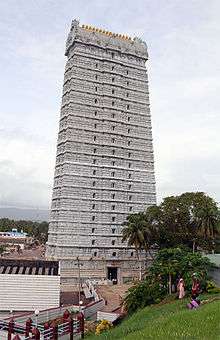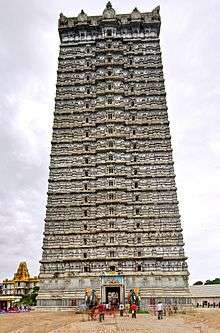Murudeshwara
| Murudeshwara ಮುರುಡೇಶ್ವರ | |
|---|---|
| Town | |
|
Gopura of Murudeshwara Temple and statue of Shiva | |
 Murudeshwara Location of Murudeshwara in Karnataka | |
| Coordinates: 14°5′37.02″N 74°29′1.77″E / 14.0936167°N 74.4838250°ECoordinates: 14°5′37.02″N 74°29′1.77″E / 14.0936167°N 74.4838250°E | |
| Country |
|
| State | Karnataka |
| District | Uttara Kannada District |
| Languages | |
| • Official | Kannada |
| Time zone | IST (UTC+5:30) |
| PIN | 581 350 |
| Telephone code | 08385 |
| Vehicle registration | KA-47 |
Murdeshwara is a town in Bhatkal Taluk of Uttara Kannada district in the state of Karnataka, India. Murudeshwara"' is another name of the Hindu god Shiva. Famous for the world's second-tallest Shiva statue, the town lies on the coast of the Arabian Sea and is also famous for the Murdeshwar Temple. Murdeshwar has a railway station on the Mangalore-Mumbai Konkan railway route.[1]
Etymology and legend

The origin of the name "Murdeshwar" dates to the time of Ramayana.
The Hindu gods attained immortality and invincibility by worshiping a divine Lingam called the Atma-Linga. The Lanka King Ravana wanted to attain immortality by obtaining the Atma-Linga (Soul of Shiva). Since the Atma-Linga belonged to Lord Shiva, Ravana worshipped Shiva with devotion. Pleased by his prayers, Lord Shiva appeared before him and asked him what he wanted. Ravana asked for the Atma-Linga. Lord Shiva agreed to give him the boon on the condition that it should never be placed on the ground before he reaches Lanka. If the Atma-Linga was ever placed on the ground, it would be impossible to move it. Having obtained his boon, Ravana started back on his journey to Lanka.
Narada, who came to know of this incident, realised that with the Atma-Linga, Ravana may obtain immortality and wreak havoc on earth. He approached Lord Ganesh and requested him to prevent the Atma-Linga from reaching Lanka. Lord Ganesh knew that Ravana was a very devoted person who performed prayer rituals every evening without fail. He decided to make use of this fact and came up with a plan to confiscate the Atma-Linga from Ravana.
As Ravana was nearing Gokarna, Lord Vishnu blotted out the sun to give the appearance of dusk. Ravana now had to perform his evening rituals but was worried because with the Atma-Linga in his hands, he would not be able to do his rituals. At this time, Lord Ganesh in the disguise of a Brahmin boy accosted him. Ravana requested him to hold the Atma-Linga until he performed his rituals, and asked him not to place it on the ground. Ganesh struck a deal with him saying that he would call Ravana thrice, and if Ravana did not return within that time, he would place the Atma-Linga on the ground.
Ravana returned to find that Ganesh had already placed the Atma-Linga on the ground. Vishnu then removed his illusion and it was daylight again. Ravana, realising that he had been tricked, tried to uproot and destroy the linga. Due to the force exerted by Ravana, some pieces were scattered. One such piece from the head of the linga is said to have fallen in present-day Surathkal. The famous Sadashiva temple is said to be built around that piece of linga. Then he decided to destroy the covering of the Atma-Linga, and threw the case covering it to a place called Sajjeshwar, 23 miles away. Then he threw the lid of the case to a place called Guneshwar (now Gunavanthe) and Dhareshwar, 10–12 miles away. Finally, he threw the cloth covering the Atma-Linga to a place called Mrideshwar in Kanduka-Giri (Kanduka Hill). Mrideshwar has been renamed to Murdeshwar.
Major attractions
- Murdeshwar Temple and Raja Gopura: This temple is built on the Kanduka Hill which is surrounded on three sides by the waters of the Arabian Sea. It is dedicated to Shiva, and a 20-storied gopura is constructed at the temple. The temple authorities have installed a lift that provides a breath-taking view of the 123-feet Shiva idol from the top of the Raja gopura. There is also a Rameshwar linga at the bottom of the hill, where devotees can do seva themselves. A Shaneswara temple has been built next to the idol of Shiva. Two life-size elephants in concrete stand guard at the steps leading to it. The entire temple and temple complex, including the 237.5-feet-tall Raja Gopura, is one among the tallest, was constructed to its present form by businessman and philanthropist R. N. Shetty.
- The temple is entirely modernized with exception of the sanctum sanctorum which is still dark and retains its composure. The main deity is Sri Mridesa Linga, also called Murudeswara. The linga is believed to be a piece of the original Atma Linga and is about two feet below ground level. The devotees performing special sevas like Abhisheka, Rudrabhisheka, Rathotsava etc. can view the deity by standing before the threshold of the sanctum and the Lingam is illuminated by oil lamps held close by the priests. The Lingam is essentially a rough rock inside a hollowed spot in the ground. Entry into the sanctum is banned for all devotees.
- Statue of great Lord Shiva: A huge towering statue of Lord Shiva, visible from great distances, is present in the temple complex. It is the second highest statue of Lord Shiva in the world. The tallest Shiva statue is in Nepal known as the(Kailashnath Mahadev Statue).[2][3] The statue is 123 feet (37 m) in height and took about two years to build. The statue was built by Shivamogga's Kashinath and several other sculptors, financed by businessman and philanthropist Dr. R.N. Shetty, at a cost of approximately Rs 50 million. The idol is designed such that it gets the sunlight directly and thus appears sparkling.[4]
- Statue of Lord Shiva
 Gopura of Murdeshwar Temple
Gopura of Murdeshwar Temple- Shikhara of Murdeshwar Temple
 Lord Shiva statue
Lord Shiva statue- Murudshwar beach with boats and jet skis
See also
References
- ↑ http://www.konkanrailway.com/node/467
- ↑ "A Shivaratri gift for people of Bijapur". The Hindu.
- ↑ World's tallest Siva idol
- ↑ madur. "Murdeshwar - Raja Gopura - Fort - Shiva Temple". Karnataka.com.
External links
| Wikimedia Commons has media related to Murudeshwara. |
